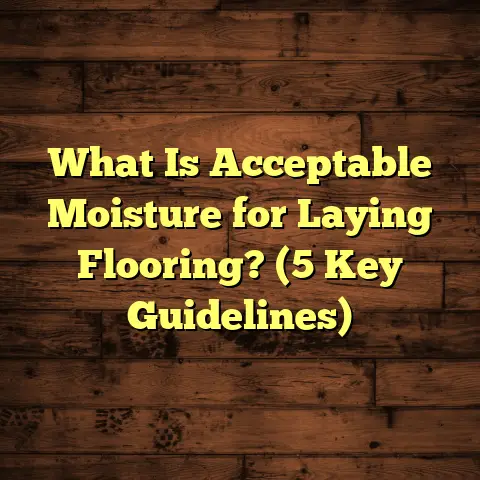What is the Cost of New 4×4 Shower Tile Floor? (5 Key Factors Revealed)
Allergies have a sneaky way of creeping into our daily lives, especially in places we least expect — like our bathrooms. I’ve seen clients struggling with mold allergies, dust mites thriving in carpeted floors, and other irritants lurking around. That’s why choosing the right flooring for your shower is more than just picking a design; it’s about creating a healthier environment. One option I often recommend is a 4×4 shower tile floor. But what’s the real cost behind it? Let me walk you through everything I’ve learned over the years.
What is a New 4×4 Shower Tile Floor?
A 4×4 shower tile floor refers to a floor made of tiles that measure 4 inches by 4 inches each. These tiles are commonly ceramic or porcelain but can also include natural stone varieties. The size makes them a popular choice because they provide enough grout lines for good traction, which helps prevent slipping in wet areas.
This tile size strikes a balance between aesthetics and functionality. It’s not as small as mosaic tiles, which can be tricky to install and clean, and not as large as 12×12 tiles, which may feel slippery in a shower setting. The 4×4 tile floor offers an attractive, practical surface that fits many bathroom styles — from classic to modern.
Why Choose 4×4 Tiles for Your Shower Floor?
I often get asked why 4×4 tiles are preferred over other sizes. Here’s my take:
- Slip resistance: The grout lines between smaller tiles add texture, helping reduce slipping hazards.
- Versatility: These tiles come in various materials, colors, and finishes.
- Ease of repair: If one tile cracks or chips, replacing a 4×4 tile is simpler and less expensive than larger tiles.
- Classic look: They give the shower floor a timeless look that pairs well with many wall tile choices.
Now that you know what this floor is, let me share some practical insights about installation, usage, maintenance, and—most importantly—the cost.
5 Key Factors That Affect the Cost of a New 4×4 Shower Tile Floor
When I quote my clients for installing a new shower tile floor using 4×4 tiles, several factors come into play. Understanding these will help you budget better and avoid surprises.
1. Material Choice: Ceramic vs. Porcelain vs. Natural Stone
Material is the single biggest cost driver.
- Ceramic Tiles: These are generally the most affordable option, costing around $1 to $5 per square foot. They’re lightweight, easy to cut, and water-resistant when glazed. However, they’re less durable than porcelain.
- Porcelain Tiles: Porcelain is denser and more durable than ceramic, with prices ranging from $3 to $10 per square foot. It’s great for high-moisture areas like showers because it absorbs less water.
- Natural Stone Tiles: Marble, travertine, or slate can cost anywhere from $5 to $20 per square foot or more. They offer a unique look but require more maintenance and sealing to prevent damage from water.
From my experience working on dozens of bathroom remodels, porcelain tiles tend to offer the best balance of durability and price for shower floors.
My Personal Experience with Materials
I remember a client who wanted natural stone — an elegant choice but one that comes with headaches if you don’t maintain it properly. We installed honed marble tiles that cost over $15 per square foot just for materials. After a year without sealing and routine maintenance, some of the tiles showed water stains and etching. We had to reseal and do some minor repairs. In contrast, another client chose porcelain at about $6 per square foot and enjoyed trouble-free use for years with minimal upkeep.
2. Labor Costs: Installation Complexity
Installing a 4×4 shower tile floor isn’t just about laying down tiles; it involves prep work like waterproofing, leveling the substrate, and grout application.
Labor rates vary by region but typically run from $5 to $15 per square foot for installation alone.
Here’s what affects labor costs:
- Surface prep: Older showers often need subfloor repairs or waterproof membrane installation.
- Tile layout complexity: Patterns or diagonal layouts take more time.
- Grout type: Epoxy grout is more expensive and trickier to install than cement-based grout but lasts longer.
For example, I had a job where the old shower pan was damaged; replacing it added nearly $500 in labor but saved the client from future leaks.
On-site Challenges That Influence Labor
In some cases, I’ve encountered showers with uneven floors or old waterproofing layers that had to be completely removed before tiling could begin. These surprises can double labor time if not accounted for upfront.
A memorable project involved a century-old home where the shower floor needed structural reinforcement before any tile work started. That alone added about $800 in labor costs but ensured the new tile floor would last decades.
3. Size of the Shower Floor
The total square footage directly impacts cost. A typical shower floor might be between 9 and 16 square feet (3’x3′ to 4’x4′). The smaller the area, the higher the cost per square foot since fixed costs like prep work don’t scale down much.
In one recent project, the shower was just 12 sq ft but had intricate tile patterns which raised labor time by 30%. So, it’s not just size but design that affects price.
4. Additional Materials: Waterproofing and Grout
Don’t forget the extras:
- Waterproof membrane: Essential to prevent leaks; costs about $1–$3 per square foot.
- Thinset mortar: Used to adhere tiles; around $0.50–$1 per square foot.
- Grout: Cement-based grout runs about $0.50–$1 per square foot; epoxy grout can be double or triple that.
- Sealants: Some tiles and grout need sealing every few years; adds to lifetime costs.
In my experience, skipping waterproofing can lead to serious problems down the road. I always budget for it upfront.
5. Maintenance and Longevity
While not an upfront cost, maintenance can add up:
- Ceramic and porcelain tiles are low-maintenance but need regular cleaning.
- Natural stone needs periodic sealing to avoid stains.
- Grout lines can discolor over time and may require cleaning or re-grouting every few years.
I once worked on a home where cheap grout was used initially without sealing; within two years, the grout was stained badly and had to be replaced at significant expense.
Breaking Down the Cost: Real Numbers from My Projects
Let me share some actual figures from three different jobs I completed over the last year:
| Project | Tile Type | Sq Ft | Tile Cost ($/sq ft) | Labor ($/sq ft) | Extra Materials | Total Cost |
|---|---|---|---|---|---|---|
| A | Ceramic | 10 | 2 | 6 | 150 | $320 |
| B | Porcelain | 15 | 5 | 7 | 200 | $555 |
| C | Natural Stone | 12 | 12 | 10 | 250 | $794 |
You can see how material choice makes a huge difference. For Project C with natural stone, the price was nearly triple compared to ceramic.
Installation Tips I Share with Clients
If you decide to go ahead with a new 4×4 shower tile floor, here are some tips from my toolbox:
- Hire a pro if you’re unsure: DIY is tempting but mistakes in waterproofing or uneven tiling can cause costly problems.
- Use quality waterproofing membrane: This protects your subfloor from moisture damage.
- Choose grout color wisely: Darker grout hides stains better but lighter grout can brighten small showers.
- Allow proper curing time: Don’t rush using your shower; wait at least 72 hours before wetting new grout.
- Keep grout sealed: This prevents mold buildup and staining.
Step-by-Step Installation Guide for DIYers
If you’re thinking about doing this yourself (I won’t stop you), here’s how I would approach it:
- Prepare the Surface: Remove old flooring, clean debris, and fix any damage.
- Install Waterproofing: Apply a waterproof membrane or liquid waterproofing system thoroughly on shower floor and walls to prevent leaks.
- Lay Out Tiles: Dry-fit your tiles first to plan cuts and pattern.
- Mix Thinset Mortar: Use manufacturer instructions for best results.
- Set Tiles: Spread thinset with a notched trowel; press tiles firmly into place.
- Cut Tiles as Needed: Use a tile cutter or wet saw carefully.
- Let Thinset Cure: Usually takes at least 24 hours.
- Apply Grout: Fill gaps between tiles using rubber float; wipe excess gently.
- Seal Grout (if required): Follow product instructions.
- Clean Tiles: Remove any haze left by grout after drying.
Be patient — rushing any step can lead to poor results!
How Maintenance Affects Long-Term Cost
A new floor doesn’t end your expenses; keeping it looking great matters too:
- Cleaning once a week prevents soap scum buildup.
- Avoid acidic cleaners on natural stone; they erode the surface.
- If you see grout discoloration early, treat it quickly with specialized cleaners or reseal it.
- Watch for loose tiles—fix them promptly before water seeps underneath causing damage.
Over time, neglecting these steps can triple your maintenance costs compared to simple regular care.
Allergies & Health: Why Bathroom Flooring Choices Matter
Back to where we started — allergies.
Bathrooms are hotspots for mold growth due to moisture exposure. Mold spores aggravate asthma and allergy symptoms. I’ve helped families who suffered daily sneezing fits until we replaced carpeted bathroom floors with tile.
Tiles don’t trap dust or allergens like carpets do. Plus, the smooth surfaces are easier to clean thoroughly with non-toxic products.
If anyone in your household struggles with allergies or respiratory issues, investing in tile flooring – especially something with good slip resistance like 4×4 tiles – can improve indoor air quality significantly.
Comparing Costs With Other Flooring Options in Showers
Some wonder why not use vinyl or linoleum sheets instead of tile?
Here’s what I tell clients:
| Flooring Type | Avg Cost per Sq Ft (Materials + Labor) | Durability in Showers | Maintenance Needs |
|---|---|---|---|
| Ceramic/Porcelain Tile (4×4) | $8 – $20 | Very High | Low — Regular cleaning & sealing |
| Vinyl Sheet | $3 – $7 | Moderate | Easy cleaning but prone to damage |
| Natural Stone | $15 – $30 | High | Requires sealing & careful maintenance |
| Marble | $20+ | Moderate | Sensitive to acids & stains |
Tile tends to last longer than vinyl options while offering better aesthetics and health benefits.
How Local Market Conditions Influence Pricing
Costs also vary depending on where you live.
- Urban areas often have higher labor rates due to demand; expect $10–$15 per sq ft labor fees.
- Rural areas might have fewer contractors but lower rates.
- Availability of materials nearby influences tile pricing too—exotic natural stones cost more when imported overseas.
Using online tools like FloorTally helps account for local market conditions by pulling real-time labor and material rates tailored to your zip code.
Case Study: How I Helped a Family Upgrade Their Allergy-Prone Bathroom
A few months ago, I worked with a family whose young son had worsening asthma attacks linked to bathroom mold exposure. Their old bathroom had carpeted floors and dated fixtures with poor ventilation.
We removed all carpets and installed a new 4×4 porcelain tile shower floor with epoxy grout sealed against moisture intrusion. We added extra ventilation fans and recommended non-toxic cleaning products.
Six weeks later, their son’s asthma symptoms had noticeably improved — fewer attacks reported by their pediatrician too.
This project cost them about $750 total for the shower floor (including materials and labor) but improved their quality of life immensely.
Frequently Asked Questions (FAQs)
Q: How long does it take to install a new 4×4 shower tile floor?
A: Typically between 2–4 days including prep work, installation, grouting, and curing times.
Q: Can I install these tiles over an existing shower floor?
A: Usually no — you need a stable substrate free of damage or moisture issues for best results.
Q: What kind of grout color should I choose?
A: Darker grouts hide stains better; lighter grouts brighten small spaces but need more upkeep.
Q: How often should grout be resealed?
A: Every 1–2 years depending on use and type of sealant applied.
My Final Thoughts on Budgeting Your Shower Tile Project
Budgeting well means thinking beyond just tile price:
- Include labor that covers prep work and waterproofing.
- Factor in quality grout & sealants for durability.
- Plan for maintenance costs down the road.
If you’re serious about avoiding costly repairs later — don’t cut corners on waterproofing or cheap materials even if initial costs seem high.
Reach out if you want help estimating your project based on your specific bathroom size and location—I use FloorTally regularly for accurate quotes that save clients money and headaches!
Thanks for sticking with me through all this info! If you’re thinking about upgrading or installing a new shower floor using those classic 4×4 tiles, hopefully you feel more prepared now—not just on costs but on making smart choices that fit your home’s needs and lifestyle.
Got questions? Just ask!





